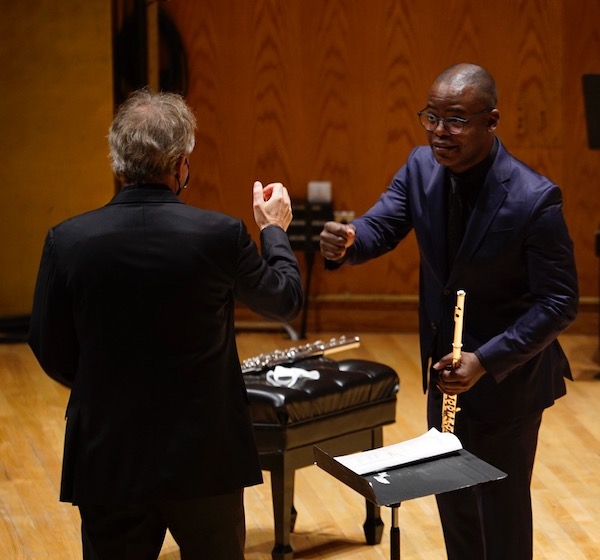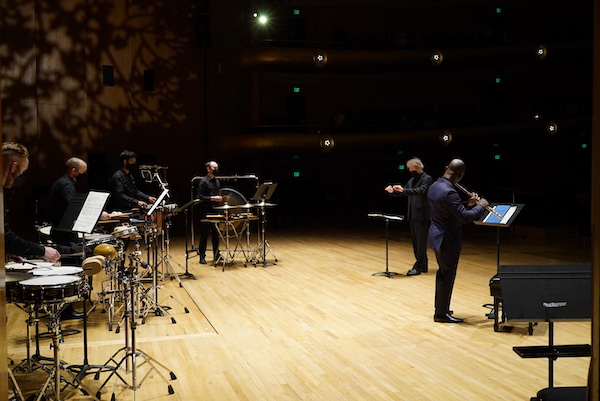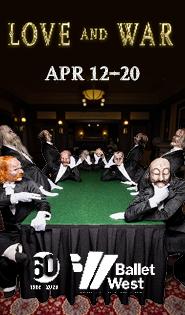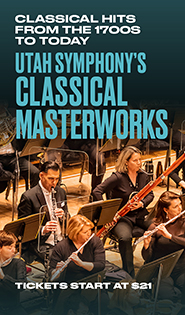Jolivet concerto and Beethoven make engaging partners with Utah Symphony

Photo: Kathleen Sykes
In a welcome sign the pandemic may be coming to an end, the Utah Symphony’s program led by Thierry Fischer Thursday night included a Beethoven symphony. Since cautiously returning last fall, the orchestra has tried to observe recommended social distancing by featuring smaller ensembles of mostly strings, which can play masked.
The sight of the Abravanel Hall stage full of musicians and the sound of a full Late Classical orchestra signaled to the sparse, socially distant audience that in a few months, they may sit unmasked in a full hall and perhaps even have a choir join the orchestra on stage.
However, the most memorable part of the evening—and a highlight of the entire season—came via André Jolivet’s Suite en concert for flute and percussion, featuring guest soloist Demarre McGill.
The French composer wrote the piece in 1965 at the request of famed French flutist Jean-Pierre Rampal, who had helped make Jolivet’s 1949 Flute Concerto part of the standard concerto repertoire. While that concerto uses a fairly standard string orchestra, the Suite en concert replaces the orchestra with four percussionists playing an array of snares, cymbals, blocks, bongos, rattles and bass drums. (There are no marimbas, xylophones or even timpani to provide counterpoint to the flute, which is the only instrument with variable pitch.) The effect is stunning, as the audience is forced to experience melody and rhythm in a more basic, primal way.
McGill, principal flutist of the Seattle Symphony, was a charismatic presence; practically dancing as he led the audience on the concerto’s musical journey. As in any effective concerto, the ensemble both competed with and complemented the soloist. Utah Symphony principal percussionist Keith Carrick, section colleagues Eric Hopkins and Michael Pape and substitute Gavin Ryan, created moods that ranged from chaotic to deeply serious. They operated as such a seamless unit that one barely noticed Fischer’s conducting. The musicians were aided by the lighting, which simulated tree branches and a forest canopy.
The first movement began ominously with brushed snares, cymbals struck with mallets, blocks, and hand drums, which quickly formed a backdrop that held the music together through the flute’s frenetic melody. McGill switched to alto flute for the solemn second movement, which had the feel of an ancient ritual and showcased his musicality and tone. By contrast, the third movement felt dangerous and aggressive, as if the flute were a small animal pursued by the various drums, hunting as a pack.

The fourth and final movement was the only one to begin with solo flute rather than percussion and it integrated the flute with the percussion in a fresh way, ultimately bringing the piece to a rousing climax, which prompted a standing ovation. As an encore McGill played Debussy’s Syrinx, an excellent choice that highlighted how Jolivet’s particular brand of atonality grew out of the impressionism of his fellow Frenchman.
Perhaps due to the logistics of getting the orchestra on stage with no intermission, Beethoven’s Symphony No. 1 in C Major came after the Jolivet and closed out the program. In order to put more distance between the musicians, the stage was extended, covering most of the first three rows. This had the effect of enveloping the audience in the piece’s joyful sound.
Beethoven’s first two symphonies are sometimes viewed as gifted imitations of Haydn (briefly, his teacher) that lack the distinctive voice that clearly emerged in his Eroica symphony. However, that’s not =really fair since the first symphony contains clear individual, Beethovenian elements. For example, it begins with an authentic cadence, followed by a series of cadences that land on a secondary dominant where the music lingers for a tense moment before finally swinging into the joyful main theme.
Thierry Fischer conducted the piece like Beethoven rather than Haydn. Instead of moments of hushed anticipation building carefully to climaxes, Fischer gave the piece a bold, relaxed, matter-of-fact feel. His interpretation served the piece well in the resolute first movement and the playful second movement. It fell short in the third movement, which lacked something in rhythmic drive and vitality. By contrast, the fourth movement was jubilant and well-executed, closing out the concert with a welcome reminder of how powerful the full Utah symphony can sound.
The Utah Symphony will repeat the program 7:30 p.m. Friday and Saturday at Abravanel Hall. Seating is limited due to social distancing. utahsymphony.org; 801-533-6683.

